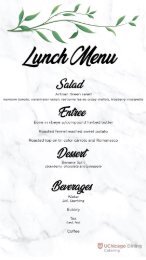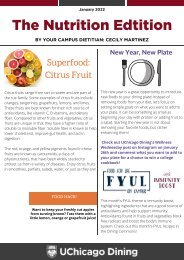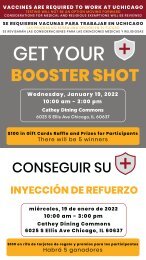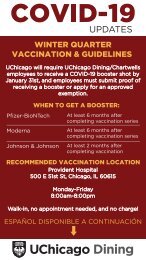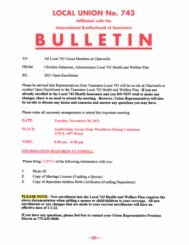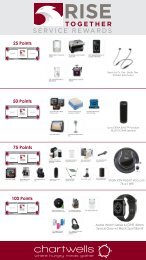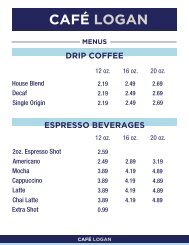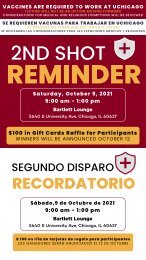Heart Healthy Eating AND 2020 498918
Create successful ePaper yourself
Turn your PDF publications into a flip-book with our unique Google optimized e-Paper software.
HEART-
HEALTHY
EATING
Academy of Nutrition and Dietetics
120 South Riverside Plaza #2190
Chicago, IL 60606
Eatright Essentials: Heart-Healthy Eating
Catalog Number: 616920
Copyright © 2020, Academy of Nutrition and Dietetics. All rights reserved. No part of this publication
may be used for commercial exploitation (for example, by resale to others) without the prior written
consent of the publisher.
The views expressed in this publication are those of the authors and do not necessarily reflect
policies and/or official positions of the Academy of Nutrition and Dietetics. Mention of product
names in this publication does not constitute endorsement by the authors or the Academy of
Nutrition and Dietetics. The Academy of Nutrition and Dietetics disclaims responsibility for the
application of the information contained herein.
For more information on the Academy of Nutrition and Dietetics, visit www.eatright.org.
HEART-HEALTHY EATING
Copyright © 2020 Academy of Nutrition and Dietetics. This handout may be reproduced for education purposes.
HEART-HEALTHY EATING HANDOUTS:
Choosing Heart-Healthy Fats
Omega-3 Fats
Plant Stanols and Sterols
Stocking a Heart-Healthy Kitchen
Fruits and Vegetables
Plant-Based Foods
Cooking Tips
Meatless Meals
Reducing Sodium While Boosting Flavors
Snacking for Heart Health
Heart-Healthy Tips for Dining Out
Reading Food Labels to Make Heart-Healthy Choices
Sugar and Heart Health
Whole Grains and Hearth Health
Physical Activity for Heart Health
HEART-HEALTHY EATING
Copyright © 2020 Academy of Nutrition and Dietetics. This handout may be reproduced for patient education.
CHOOSING HEART-
HEALTHY FATS
Eating some fat at your meals and snacks is actually healthy.
Fat helps your body absorb certain nutrients. It adds flavor
and texture to the foods you eat, and it helps you feel
satisfied after a meal. It is important to understand which
fats are healthiest so you can make the best choices.
EXAMPLES OF HEALTHY FATS
Monounsaturated fat
▶
▶
▶
▶
▶
▶
Olive oil
Peanut oil
Canola oil
Avocados
Nuts and seeds
Peanut butter
Polyunsaturated fat
▶
▶
▶
▶
▶
▶
▶
Soybean oil (often called
“vegetable oil”)
Corn oil
Safflower oil
Soft tub margarines
Walnuts
Flaxseed
Sunflower seeds
Omega-3 Fats
▶
▶
▶
Fatty or oily fish, such as
salmon, mackerel, tuna,
sardines, herring
Walnuts
Ground flaxseed
▶ Flaxseed oil
Which Fats Are Healthy Fats?
Some types of fat are healthier for you (and your heart) than
other types. Choose these types of fat more often:
▶
▶
Monounsaturated and polyunsaturated fats: these fats
can help lower your total cholesterol and your LDL (“bad”)
cholesterol.
Omega-3 fats: these are a type of polyunsaturated fat
and may help improve your heart health by reducing
plaque buildup in the arteries and decreasing
triglycerides (unhealthy fats) in the blood.
Which Fats Are Unhealthy Fats?
Eating saturated and trans fats increases your total
cholesterol and LDL (“bad”) cholesterol. These fats also
raise your risk for heart disease. Choose these types of fats
less often.
▶
▶
Replace saturated fats with healthier types of fats
whenever possible. For example, cook or bake with olive
oil or canola oil instead of butter or stick margarine.
Aim to limit saturated fat and avoid trans fats. Look for
foods without hydrogenated or partially hydrogenated
oil listed as an ingredient. (Note: If you like a food that has
trans fat, compare food labels of similar products. Some
may be made without unhealthy fats.)
HEART-HEALTHY EATING
Copyright © 2020 Academy of Nutrition and Dietetics. This handout may be reproduced for education purposes.
CHOOSING HEART-HEALTHY FATS
SOURCES OF UNHEALTHY FATS
Saturated Fat
▶
▶
▶
▶
▶
Meats
Poultry with skin
Coconut oil
Palm oil and other
tropical oils
Higher fat dairy products,
such as whole or 2% milk,
cream, butter, and
ice cream
Trans Fat*
▶
▶
▶
▶
▶
▶
Stick margarine
Chips and crackers
Cookies
Doughnuts
Pastries
French fries
* Check the Nutrition Facts and
ingredients list to see if these
products contain trans fat.
What About Dietary Cholesterol?
Cholesterol is found in many of the same foods that have
saturated fat. Meats, dairy foods, butter, eggs, and other
animal products contain cholesterol. Therefore, if you limit
foods with saturated fat, you will eat less cholesterol, too.
There are no daily limits for cholesterol, but you should still
try to watch your cholesterol intake since foods that are
high in cholesterol also tend to be high in saturated fats.
Meal Planning Tips
The following tips can help you include healthier fats
more often. They will help you limit the amount of dietary
cholesterol you eat, too.
• Cook or bake with heart-healthy oils, such as olive oil
or canola oil.
• Enjoy a 1-ounces serving of unsalted nuts as
a snack.
• Add ground flaxseed and berries to low-fat yogurt
for a quick and easy breakfast.
• Have a slice of avocado on your sandwich instead of
mayonnaise or butter.
• Remove the skin from chicken and turkey.
• Choose lean cuts of meat. For beef, try top round or
sirloin steak. For pork, try top loin chop or tenderloin.
• Eat a seafood meal 2 times each week.
• Plan at least 1 meatless meal each week.
CHOOSING HEART-HEALTHY FATS
Copyright © 2020 Academy of Nutrition and Dietetics. This handout may be reproduced for patient education.
OMEGA-3 FATS
Omega-3 fatty acids are a healthy fat found in some foods.
This type of fat can help reduce build-up in your arteries.
Omega-3s may also decrease triglycerides (unhealthy fats)
in your blood.
Eating foods with omega-3 fats each week may reduce
your risk of heart disease. This includes certain fish and
seafood as well as some vegetable oils, nuts, seeds, and
soy foods.
Which Foods Provide Omega-3s?
EPA AND DHA
Fish and other seafood contain the omega-3 fatty
acids known as eicosapentaenoic acid (EPA) and
docosahexaenoic acid (DHA). Aim to eat 2 servings of fish
or seafood each week. 1 serving is 4 ounces cooked (about
the size of a deck of cards).
▶
▶
▶
▶
▶
▶
▶
▶
Foods that provide EPA and DHA include:
albacore tuna
salmon
trout
halibut
mackerel (atlantic and pacific)
herring
sardines
shellfish, such as crab, lobster, and shrimp
ALA
Certain plant-based foods contain the omega-3 fatty
acid known as ALA (alpha-linolenic acid). Foods high in
ALA include:
▶
▶
▶
▶
walnuts
ground flaxseed
hemp seeds
canola oil, soybean oil, and walnut oil
HEART-HEALTHY EATING
Copyright © 2020 Academy of Nutrition and Dietetics. This handout may be reproduced for education purposes.
OMEGA-3 FATS
WHAT ABOUT MERCURY?
Mercury is an element that
occurs naturally and can
collect in streams, lakes, and
oceans. Fish absorb mercury
from the food they eat, and it
can build up in some types of
fish, especially in larger fish
that eat other fish and those
fish that live longer. Mercury
can be harmful to the brain
and nervous system if a person
is exposed to too much of it
over time.
Certain types of fish, such as
shark, tilefish (from the Gulf
of Mexico), swordfish, orange
roughy, bigeye tuna, and king
mackerel, have high levels of
mercury. For most people, a
variety of seafood and choices
that are lower in mercury
are recommended, such as
salmon, herring, trout, and
Atlantic or Pacific mackerel.
However, children and
women who are pregnant
or breastfeeding should
avoid eating any fish with
high mercury levels. Those
with moderate amounts of
mercury, such as halibut
or albacore tuna, may be
limited to 1 serving per week,
according to the US Food and
Drug Administration (FDA) and
Environmental Protection
Agency’s (EPA) current advice.
For more information, see
www.FDA.gov/fishadvice
▶
foods that are fortified with ALA, such as certain types
orange juice, yogurt, and tub margarine (read food
labels to find these products.)
Meal Planning Tips
Here are some ways to fit omega-3s into your daily meals
and snacks:
▶
▶
▶
▶
▶
▶
Add hemp seeds or ground flaxseed to cereals, yogurt,
and salads.
Substitute ground flaxseed for butter or oil when
baking. Use 3 Tablespoon of ground flaxseed instead of
1 Tablespoon of oil.
Use vegetable oils, such as flaxseed oil, walnut oil, canola
oil, or soybean oil.
Top mixed greens with 4 ounces of grilled salmon for a
delicious and hearty salad.
Snack on edamame or unsalted walnuts, or toss them
into a salad.
Get the most benefits from fish by choosing hearthealthy
cooking methods:
■
■
Grill, steam, bake, or broil fish instead of frying it.
Flavor fish with low-sodium, low-fat seasonings, such
as lemon, spices, and herbs.
Omega-3 Supplements
Omega-3 supplements may be beneficial in combating
heart disease. You may benefit from taking an omega-3
supplement if:
▶
You are unable to eat
the recommended
servings of fish or
seafood per week.
OR
▶
You have high
triglycerides.
Talk to your health care provider to find out if an omega-3
supplement is right for you.
OMEGA-3 FATS
Copyright © 2020 Academy of Nutrition and Dietetics. This handout may be reproduced for patient education.
PLANT STANOLS
AND STEROLS
Eating plant stanols and sterols may help lower LDL (“bad”)
cholesterol levels in your blood and reduce your risk of
heart disease. Read on to learn more!
ARE PLANT STANOLS AND
STEROLS THE SAME AS
STATINS?
No, plant stanols and sterols
are substances found naturally
in certain plant-based foods,
while statins are medications
prescribed by a doctor.
Both work by lowering LDL
cholesterol, but in different
ways. Statins work by reducing
the amount of LDL cholesterol
that your liver makes and by
helping your body remove
cholesterol that’s built up in
your arteries. Plant stanols
and sterols help to prevent
cholesterol from being
absorbed from the intestines
into the bloodstream.
Talk to your health care
provider if you have further
questions about plant stanols
and sterols or other issues
related to medications.
What Are Plant Stanols and Sterols?
Plant stanols and sterols, also called phytosterols, are
natural substances. They are found in small amounts in
plant-based foods, such as:
▶
▶
▶
▶
▶
▶
vegetables (such as Brussels sprouts),
fruits,
beans and peas,
nuts and seeds, such as peanuts and almonds,
vegetable oils (corn, sesame, canola, and olive oil), and
wheat germ and wheat bran.
How Do Stanols and Sterols Help Lower
Cholesterol?
Your body absorbs cholesterol into the bloodstream
from certain foods you eat. Plant stanols and sterols are
similar in size and shape to cholesterol. When you eat plant
stanols and sterols, they compete with cholesterol from
other foods for absorption in your intestines.
As a result, some cholesterol in your digestive system is
blocked. The cholesterol that is not absorbed leaves your
body as waste. This can help lower LDL cholesterol levels in
your blood.
How Much Should I Eat?
To help lower your LDL-cholesterol level, eat plant stanols
and sterols regularly along with a heart-healthy eating
plan. Aim to eat at least 2 gram of plant stanols or sterols
every day.
HEART-HEALTHY EATING
Copyright © 2020 Academy of Nutrition and Dietetics. This handout may be reproduced for education purposes.
PLANT STANOLS AND STEROLS
On average, eating this amount may lower LDL
cholesterol by 5% to 10%. For example, if your LDL
cholesterol is 150 mg/dL and you add foods with 2 gram of
plant stanols or sterols to your daily meal plan, you could
lower your LDL cholesterol to 135 mg/dL.
Since the amount of plant stanols and sterols found
naturally in most foods is quite low, some manufacturers
add plant stanols and sterols to foods such as:
▶
▶
▶
▶
▶
▶
margarine spreads,
orange juice,
granola bars,
cereal,
salad dressings, and
yogurt.
Check the food label for the amount of plant sterols or
stanols per serving.
What Else Can I Do to Lower
Cholesterol?
Plant stanols and sterols may help reduce LDL cholesterol
in your blood. However, they are not a replacement for
a healthy lifestyle. To lower your cholesterol, you need
to be physically active, eat healthy, and perhaps take
medication.
PLANT STANOLS AND STEROLS
Copyright © 2020 Academy of Nutrition and Dietetics. This handout may be reproduced for patient education.
STOCKING A HEART-
HEALTHY KITCHEN
When you have a choice of heart-healthy foods in your
kitchen, meal planning and healthy eating become much
easier. This handout offers lists of nutritious foods that you
may want to keep on hand. These foods can help you eat
heart-healthy and may reduce your risk of heart disease.
Fruits and Vegetables
▶
▶
▶
▶
▶
▶
Fresh, seasonal fruits and
vegetables
Frozen fruits and vegetables
(without added sauces or
syrups)
Dried fruit (keep portions
small, such as a small
handful)
Canned fruit packed in
water or light syrup
Lower-sodium canned
vegetables (look for
reduced sodium or “no
added salt” on labels)
Potatoes, sweet potatoes
Leaner Cuts of Meat and
Poultry
▶
▶
▶
▶
▶
▶
▶
Beef: eye of round, top
round, sirloin; 90% (or
higher) lean ground beef
Pork: tenderloin, sirloin,
top loin
Veal: shoulder, ground veal,
cutlets, sirloin
Lamb: leg shank, loin
Skinless chicken or turkey
Bison
Wild game, such as venison
or skinless pheasant
or duck
TIP
Keep fresh, whole-washed
fruits in a bowl on your kitchen
counter or table as a reminder
to eat a healthy snack. Also,
move fruits and vegetables
from the produce drawer to
a place in your refrigerator
where they are easily seen and
accessible.
Fresh or Frozen Fish
▶ Salmon
▶ Herring
▶ Albacore tuna
▶ Sardines
▶ Mackerel
▶ Trout
HEART-HEALTHY EATING
Copyright © 2020 Academy of Nutrition and Dietetics. This handout may be reproduced for education purposes.
STOCKING A HEART-HEALTHY KITCHEN
Whole Grains
▶
▶
▶
▶
▶
▶
▶
▶
▶
Oils
▶
▶
▶
▶
▶
▶
▶
▶
Tip
100% whole grain breads
and pitas
Rolled or steel cut oats
Whole grain cereals
Whole grain crackers (trans
fat free and low sodium)
Whole grain pasta
Brown and wild rice
Corn and whole wheat
tortillas
Bulgur (cracked wheat),
quinoa, whole grain barley,
millet
Whole wheat flour
Olive oil
Nut oils, such as peanut
or walnut
Canola oil
Safflower oil
Soybean oil
Liquid or soft tub
margarines
Reduced-fat, lower calorie
salad dressings
Nonfat cooking spray
Canned beans are usually
high in sodium (salt). Look for
cans labeled “low sodium” or
“no salt added,” or cook with
dried beans instead. Draining
and rinsing canned beans and
vegetables will also help to
reduce the amount of sodium.
Nuts and Seeds
▶
▶
▶
Herbs, Spices, and Other
Seasonings
▶
▶
▶
▶
▶
Ground flaxseed
Unsalted nuts, such as
walnuts, almonds, and
peanuts
Peanut butter, almond
butter, other nut butters
Legumes
▶
▶
▶
▶
▶
▶
▶
▶
Edamame (soy beans)
Tofu
Lentils
Peas
Black beans
Pinto beans
Navy beans and other
white beans
Garbanzo beans (chickpeas)
Basil, bay leaves, dill,
rosemary, thyme, and
other herbs
Allspice, cinnamon, cumin,
ginger, nutmeg, paprika, red
or black pepper, and
other spices
Garlic and onion powders
(salt-free)
Fresh or dried chili peppers
Italian seasoning, herbes de
Provence, and other saltfree
seasoning mixes
Dairy and Eggs
▶
▶
▶
▶
▶
Other Kitchen Staples
▶
▶
▶
▶
▶
▶
Reduced-sodium soups
Reduced-sodium
prepared meals
Plain popcorn or light
microwave popcorn
Reduced-sodium chicken,
beef, or vegetable broth
Various vinegars, such as
balsamic, apple cider, and
red wine
Foods enriched with plant
stanols and sterols, such as
enriched margarine, orange
juice, or yogurt
Condiments and Spreads
▶
▶
▶
▶
▶
▶
Low-fat (1%) or nonfat
(skim) milk
Low-fat or nonfat yogurt
Low- and reduced-fat
cheese, such as part-skim
mozzarella, farmer’s cheese,
or string cheese
Low-fat or nonfat cottage
cheese and sour cream
Eggs and egg substitutes
Ketchup
Mustard
Barbeque sauce
Reduced-sodium soy sauce
Hummus
Reduced-fat or light
mayonnaise
STOCKING A HEART-HEALTHY KITCHEN
Copyright © 2020 Academy of Nutrition and Dietetics. This handout may be reproduced for patient education.
FRUITS AND
VEGETABLES
Fruits and vegetables have the nutrients your body needs
to stay healthy and reduce the risk of disease. Eating
plenty of fruits and vegetables can assist with managing
your weight, help prevent stroke and some cancers, and
decrease your risk of heart disease.
WHAT COUNTS AS A CUP?
▶
▶
▶
▶
1 cup of raw or cooked
vegetables
2 cups of leafy greens
1 medium-size fruit
(size of a tennis ball)
½ cup 100% vegetable juice
1 cup 100% fruit juice
How Much Do I Need?
The amount of fruits and vegetables you need depends on
your daily calorie goals. For example, a person who needs
2,000 calories a day should aim for 4 ½ cups of fruits and
vegetables each day. Visit ChooseMyPlate.gov to find your
daily goals.
What Kinds of Fruits and Vegetables
Should I Eat?
To get a full range of healthy nutrients, plan to eat a variety
of fruits and vegetables each day:
▶
▶
At each meal, fill half of your plate with a range of
colorful fruits and vegetables. Eat fruits and vegetables
for snacks, too.
Include any form of unsweetened fruits and servings
from all of the vegetable subgroups each week.
Look for:
▶
▶
▶
½ cup of dried fruit
1 cup fresh, frozen, or
canned fruit
■
■
■
■
■
■
seasonal fresh fruits
dark green, red, and orange vegetables; beans and
peas; starchy types; and other vegetables
frozen fruits and vegetables
canned fruit packed in water or natural juices
low- or reduced-sodium canned vegetables or juice
100% fruit juice (Note: Fruit juice has about 2 times
the calories of a single piece of fruit and provides
little or no dietary fiber.)
HEART-HEALTHY EATING
Copyright © 2020 Academy of Nutrition and Dietetics. This handout may be reproduced for education purposes.
FRUITS AND VEGETABLES
EAT THE RAINBOW
Red
Cherries, red apples,
strawberries,
radishes, tomatoes
Orange and Yellow
Bananas, apricots,
oranges, sweet
potatoes, squash,
pumpkins, orange
and yellow peppers
Blue and Purple
Blueberries, plums,
purple grapes,
blackberries,
eggplant
Green
Green apples,
green pears, kiwi,
avocados, green
peppers, broccoli,
green peas, green
beans, spinach and
other dark, leafy
greens
▶
■
If you tend to eat the same fruits and vegetables
all the time, aim to try 1 new fruit or vegetable each
week. Encourage your kids to try new types, too.
This will make them more likely to eat fruits and
vegetables as adults!
Follow the colors of the rainbow to guide your meals and
snacks. The more colorful your plate, the better.
Sample Menu
What does a day filled with colorful fruits and vegetables
look like? Here’s an example to get you started:
▶ Breakfast: 2 slices of 100% whole wheat toast with 2
Tablespoon of peanut butter and a small sliced banana
▶
▶
▶
▶
Snack: 1 cup of low-fat yogurt with 1 cup of blueberries
Lunch: a 6-inch whole grain tortilla wrap filled with 2 to
3 ounces of sliced chicken, 1 cup of mixed peppers, and
sliced avocado
Snack: 1 large orange
Dinner: 2 cups of mixed salad greens topped with a
small grilled chicken breast (3 ounces) and 4 large
strawberries ( sliced), lightly tossed in 2 tablespoons of
balsamic salad dressing
White
Onion, cauliflower,
mushrooms, jicama
FRUITS AND VEGETABLES
Copyright © 2020 Academy of Nutrition and Dietetics. This handout may be reproduced for patient education.
PLANT-BASED FOODS
Eating more plant-based foods may help you lower your
blood pressure, maintain a healthy body weight, and
improve your heart health. These are foods that come
from various plants, including vegetables, fruits, whole
grains, legumes, seeds, and nuts. For the greatest benefits,
eat a wide variety of the plant-based foods described in
this handout.
Fruits and Vegetables
Aim to eat at least 4½ cups of fruits and vegetables every
day. Different colored fruits and vegetables contain
different nutrients, so it’s best to select a full range of
colorful choices.
Here are some tips to get you started:
▶
▶
▶
▶
Include at least 1 fruit or vegetable at each meal
or snack.
Wash and cut up fruits and vegetables in advance for a
quick snack or addition to a meal.
Keep fruits and vegetables in the front of your
refrigerator where you can see them. Don’t hide them in
the produce drawer.
Choose fresh or plain frozen fruits and vegetables. If you
eat canned products, choose low-sodium or no-saltadded
vegetables, and stick to fruits canned in water or
natural juices (instead of syrup).
Whole Grains
Whole grains are packed with dietary fiber, B vitamins, and
minerals such as iron, magnesium, and selenium. Aim to
eat at least 3 servings of whole grains each day. (At least
half of your daily grain servings should be whole grains.) 1
serving of whole grains equals ½ cup cooked whole grain
pasta, wild rice, brown rice, or oatmeal; 1 slice of whole
grain bread; or 3 cups of popcorn.
Here are some ways to eat more whole grains:
▶
Switch to 100% whole grain bread and whole wheat
flour.
HEART-HEALTHY EATING
Copyright © 2020 Academy of Nutrition and Dietetics. This handout may be reproduced for education purposes.
PLANT-BASED FOODS
▶
▶
▶
▶
Eat oatmeal or 100% whole grain cereal for a quick and
easy breakfast.
Substitute brown rice or wild rice for white rice.
Choose whole wheat pasta.
Explore different types of grains like quinoa, bulgur, whole
grain barley, millet, and amaranth.
Legumes (Beans)
1 serving of beans (½ cup cooked) is packed with nutrients.
Beans are rich in dietary fiber, vitamins, minerals, antioxidants,
and protein. Beans can count as vegetables or protein foods:
1 cup of cooked beans count as 1 cup of vegetables, or ¼ cup
of cooked beans count as 1-ounces equivalent in the protein
foods group.
To add more beans to your meals, try these tips:
▶
▶
▶
▶
Include black beans, soybeans, kidney beans, chickpeas, or
white beans in salads, soups, and main dishes.
Use beans instead of some or all of the beef, chicken, and
pork in your favorite recipes.
Make a tasty soup using dried lentils or split peas, which
cook faster than other dried legumes.
Rinse canned beans to remove extra salt. You can also
choose canned beans without added salt or cook with
dried legumes.
Nuts and Seeds
Nuts and seeds are full of heart-healthy fats
(monounsaturated and polyunsaturated fats). They also
provide dietary fiber, vitamins, and minerals.
1 serving of nuts or seeds is about ½ ounces. Examples of
a serving are 12 almonds, 24 pistachios, 7 walnut halves, ½
ounces of pumpkin or sunflower seeds, or 1 Tablespoon of
peanut butter or almond butter.
▶
▶
Here are a few ideas to get you started:
Enjoy a serving of unsalted nuts or seeds as a hearthealthy
snack.
Add unsalted nuts or seeds to salads or stir-fries.
▶ Snack on a slice of whole grain bread spread with 1
Tablespoon of nut butter.
PLANT-BASED FOODS
Copyright © 2020 Academy of Nutrition and Dietetics. This handout may be reproduced for patient education.
COOKING TIPS
When you cook meals at home, you are in control of how
foods are prepared and the ingredients and amounts
used. Here are some simple tips that will allow you to enjoy
your favorite foods without giving up flavor.
Use Low-Fat Cooking and
Baking Methods
Bake, broil, roast, sauté, steam, or grill foods. Unlike frying,
these cooking methods use little to no fat.
When baking, replace up to half the fat from butter,
margarine, or oil in a recipe with an equal amount of
applesauce or other pureed fruit.
Choose Healthy Fats
Use heart-healthy fats like olive oil or canola oil instead of
solid fats like butter, stick margarine, or shortening.
Choose Nonfat or Low-Fat
Dairy Products
Cut saturated fats from the foods you eat by replacing
whole milk dairy products with low-fat or nonfat
alternatives.
Reduce Added Sugars
Many foods with added sugars supply calories and very
few nutrients. Limit regular soft drinks, fruit drinks, candy,
cakes, cookies, and pies. Save your added sugars for foods
that also provide important nutrients, such as whole grain,
ready-to-eat cereals; instant oatmeal; or flavored yogurt.
Season Your Foods (Without Salt)
Enhance the flavor of foods with fresh or dried herbs,
spices, onion, garlic, vinegar, or citrus juice rather than
salt or other high-sodium seasonings. Experiment with
different herbs and spices in dishes you make often to find
your favorite flavor combinations.
HEART-HEALTHY EATING
Copyright © 2020 Academy of Nutrition and Dietetics. This handout may be reproduced for education purposes.
COOKING TIPS
Eat More Fruits and Vegetables
Fruits and vegetables add color, texture, flavor, and
nutrients to your meals. They are also naturally low in fat
and provide heart-healthy dietary fiber.
Add extra fruits and vegetables to dishes such as
casseroles or stir-fries. Balance out a serving of lean meat,
fish, or poultry with a serving of whole grains, like brown
rice. Then fill the other half of your plate with fruits and
vegetables.
Choose Whole Grains
Whole grains offer more nutrients than refined grains. For
your next meal, prepare wild rice, brown rice, or quinoa
instead of white rice. Serve whole wheat dinner rolls in
place of white rolls.
Go for Lean Meats
Look for the words round or loin on beef or pork labeling.
These cuts, such as round steak or pork tenderloin,
typically have less saturated fat.
Trim off any visible fat from meat before cooking. With
poultry, choose lean white meat (breasts) instead of the
fattier dark meat (legs and thighs), and remove the skin
before eating.
COOKING TIPS
Copyright © 2020 Academy of Nutrition and Dietetics. This handout may be reproduced for patient education.
MEATLESS MEALS
Meals that contain mostly plant-based foods help to provide
more dietary fiber, healthy fats, vitamins, and antioxidants.
Eating meatless meals more often may lower your risk of heart
disease and type 2 diabetes, reduce blood pressure, lower
cholesterol levels, and help you manage your weight.
Read on for tips on planning meatless meals that meet your
daily nutrition needs. Keep in mind that variety is the key to
planning meatless meals that are both satisfying and healthy.
Will I Get Enough Protein?
Many people worry that meatless meals lack protein. In fact,
many plant foods supply protein too. Most people can meet
their daily needs by choosing plant foods that supply protein.
Try to include a variety of foods in meatless meals to help
meet your daily protein needs. Here are some examples:
▶
▶
▶
▶
▶
▶
foods made from soybeans, such as soymilk, tofu, and soybased
meat substitutes (soy crumbles, soy burgers)
whole grains, such as quinoa, brown rice, wild rice, whole
grain breads, and whole grain pasta
legumes, such as kidney beans, pinto beans, black beans,
lentils, and split peas
nuts, seeds, and nut butters, such as peanut butter or
almond butter
low-fat or fat-free milk, cheese, and yogurt
eggs
How Can I Get Started?
At first, plan and prepare a meatless meal 1 time each week.
Over time, work up to 2 or 3 meatless meals per week.
Prepare your favorite recipes minus the meat. For
example, make tacos with beans and vegetables. Or, try meat
substitutes (like soy crumbles).
Find new dishes to prepare. Browse cooking websites
and cookbooks for healthy vegetarian recipes. Also ask your
friends, family, and coworkers for suggestions.
HEART-HEALTHY EATING
Copyright © 2020 Academy of Nutrition and Dietetics. This handout may be reproduced for education purposes.
MEATLESS MEALS
Sample Meatless Breakfasts
▶
▶
▶
1 slice of whole grain toast with 1 Tablespoon of peanut
butter and a sliced banana
1 cup of low-fat Greek yogurt topped with 1 cup of
mixed berries and ¼ cup of whole grain cereal, such as
low-fat granola
2 eggs scrambled with leftover vegetables and a toasted
whole grain English muffin
Sample Meatless Lunches
▶
▶
▶
2 slices of toasted whole grain bread topped with 1½ ounces
of fresh, low-fat mozzarella cheese, 1 cup of tomato slices,
and raw spinach, drizzled with balsamic vinegar
1 cup of low-sodium vegetable soup or vegetarian chili,
served with a whole wheat dinner roll and a leafy green salad
or a piece of fresh fruit
½ cup of leftover brown rice or quinoa, served over salad
greens and topped with 3 slices of avocado, salsa, corn, and
tortilla strips
Sample Meatless Dinners
▶
▶
▶
1 cup of whole grain pasta served with ½ cup of tomato
sauce with crumbled meat substitute plus added
vegetables, such as mushrooms, tomatoes, eggplant,
peppers, and onions
1 cup of vegetable stir-fry with ½ ounces of nuts or ¼ cup
of tofu, served with ½ cup of brown rice
Veggie pizza made with a precooked whole grain crust and
topped with roasted vegetables, mozzarella or goat cheese,
and drizzled with balsamic vinegar
Sample Meatless Snacks
▶
▶
▶
▶
▶
1 piece of fresh fruit or 1 cup of chopped fruit or berries
1 ounce of whole grain crackers and 2 Tablespoon of hummus
1 cup of low-fat or nonfat yogurt
3 cups of low-fat popcorn
1 cup of cut-up raw vegetables served with 2 Tablespoon of
low-fat dip or salsa
MEATLESS MEALS
Copyright © 2020 Academy of Nutrition and Dietetics. This handout may be reproduced for patient education.
REDUCING SODIUM
WHILE BOOSTING
FLAVORS
Eating less sodium (salt) can help reduce your blood
pressure and improve your heart health. Your body needs
some sodium, but most Americans get much more than the
recommended amount each day.
The good news is that you can reduce the sodium in the
foods you eat and drink while still maintaining great flavor.
Read on to find out how!
Meal Planning Tips
▶
▶
▶
▶
▶
Read food labels. The Nutrition Facts label tells you how
many milligrams (mg) of sodium are in 1 serving. Most of
the sodium we eat comes from processed and packaged
foods. Compare food labels for similar products. Foods
labeled as “reduced sodium,” “low sodium,” “lightly salted,”
“unsalted,” or “no salt added” are better options than the
original, higher sodium product.
Substitute other flavorful ingredients for salt. Remove the
salt shaker from your kitchen and dining room. Instead of
salting food, get creative: add flavor with lemon juice, olive
oil, vinegar, and herbs and spices, such as basil, curry, dill,
garlic, onion powder, oregano, paprika, or rosemary.
Cut back on salt when dining out. Making foods at home is
the best way to limit the sodium you eat. When you eat out,
ask that the chef prepare your food without added salt or
other high-sodium ingredients.
Eat more potassium. Foods high in potassium can help
lower your blood pressure. High-potassium foods include
sweet potatoes, tomatoes, white beans, yogurt, bananas,
apricots, and spinach.
Enjoy lower sodium foods from every food group. Review
the chart on the next page. The Choose Less Often foods
are higher in sodium. The Choose More Often foods are
lower sodium alternatives.
HEART-HEALTHY EATING
Copyright © 2020 Academy of Nutrition and Dietetics. This handout may be reproduced for education purposes.
REDUCING SODIUM WHILE BOOSTING FLAVORS
Grains
▶
▶
Choose less often: Salted
breads and crackers; most
ready-to-eat cereals and
instant hot cereals
Choose more often:
Lower-sodium breads and
crackers; slow-cooked
rolled or steel cut oats;
puffed wheat, puffed rice, or
shredded wheat cereals
Dairy
▶
▶
Choose less often:
Processed cheese;
cottage cheese
Choose more often: Lowersodium,
reduced-fat cheese
and cottage cheese; low-fat
or nonfat yogurt
Protein Foods
▶
▶
Choose less often: Bacon,
ham, pastrami, corned
beef, salami, bologna, hot
dogs, sausages; smoked or
canned fish; canned beans
with added salt
Choose more often: Fresh
or frozen lean meat, skinless
poultry, and fresh or frozen
fish; eggs; unsalted nuts;
dried beans or no-saltadded
canned beans
Vegetables and Fruits
▶
▶
Choose less often: Canned
vegetables; vegetable
juices; jarred or canned
pasta sauces
Choose more often: Fresh
or frozen vegetables
(without sauces); lowersodium
canned vegetables,
juices, and tomato sauces;
fresh and frozen fruits;
fruits canned in water or
natural juices (all fruits are
naturally low in sodium)
Fats/Oils
▶
▶
Choose less often: Salted
butter or margarine;
packaged sauces, gravies,
and salad dressings
Choose more often:
Unsalted butter or tub
margarine; cooking oils;
reduced-sodium or salt-free
sauces, gravies, and salad
dressings
Condiments
▶
▶
Choose less often: Table
salt; relish; barbeque sauce;
soy sauce; garlic salt; other
seasoning mixes with salt
Choose more often: Lemon
juice; fresh or dried herbs;
vinegar; reduced-sodium
soy sauce; spices; seasoning
blends that do not
contain salt
REDUCING SODIUM WHILE BOOSTING FLAVORS
Copyright © 2020 Academy of Nutrition and Dietetics. This handout may be reproduced for patient education.
SNACKING FOR
HEART HEALTH
Snacking can be part of a healthy eating plan and may
even have heart-healthy benefits. For example, snacking
may help you:
▶
▶
▶
stay energized throughout the day;
eat more healthy foods, such as fruits and vegetables,
which help lower blood pressure and improve heart
health; and
manage your weight by controlling your hunger levels.
(If you go too long without eating, you may eat too many
calories and too much fat at your next meal.)
Making Healthy Snack Choices
Plan your meals and snacks to make sure you eat a variety
of healthy foods. Stock your refrigerator and pantry with
healthy snack options. That way, when you are ready for a
snack, you have plenty of choices.
Keep Portion Control in Mind
Portion your snacks before you eat. Eating directly from
the package or container may lead to overeating.
Avoid Mindless Snacking
Snack only when you feel hungry, not when you feel bored
or stressed. Try to eat a snack without doing something
else at the same time, like watching TV.
Of course, the key is to make healthy snack choices. Read
on to learn more about healthy snacking!
HEART-HEALTHY EATING
Copyright © 2020 Academy of Nutrition and Dietetics. This handout may be reproduced for education purposes.
SNACKING FOR HEART HEALTH
Hearty Snacks
▶
1 cup of low-fat yogurt with 1 cup of blueberries;
consider adding ground flaxseed for a hearthealthy
boost
▶ 1 toasted slice of 100% whole grain bread with 1
Tablespoon of peanut butter (or other nut butter)
▶
▶
▶
A medium apple with 1 Tablespoon of peanut butter
1½ ounces of low-fat cheese with 7 whole
grain crackers
¼ cup of trail mix made with a blend of heart-healthy
ingredients such as unsalted walnuts, pecans, almonds,
hazelnuts, pistachios, and dried fruit
Light and Crunchy Snacks
▶
▶
▶
▶
▶
▶
Chopped veggies, such as carrots, celery, green and red
peppers, broccoli, cauliflower, or cherry tomatoes, with
low-fat dip or hummus
A small portion (1 ounces) of unsalted nuts, such as
walnuts, almonds, peanuts, or pistachios
An apple or other piece of fresh fruit
1/3 cup of dried fruit (raisins, bananas, peaches, etc.)
Salsa served with 1 serving of low-fat, whole grain
tortilla chips
3 cups of low-fat popcorn (lightly salted or without
added salt)
Sweet Snacks
▶
▶
▶
▶
▶
▶
1 apple or other piece of fresh fruit
Frozen grapes or a frozen banana
1 ounces of dark chocolate
1 cup of pudding made with low-fat or nonfat milk
1 cup of low-fat yogurt
1 cup (8 ounces) of hot chocolate or latte made with
low-fat or nonfat milk
SNACKING FOR HEART HEALTH
Copyright © 2020 Academy of Nutrition and Dietetics. This handout may be reproduced for patient education.
HEART-HEALTHY TIPS
FOR DINING OUT
The average American eats out several times each week.
When you learn how to choose heart-healthy options,
you can enjoy eating at restaurants while maintaining a
healthier lifestyle. Here are some tips to follow.
Eat Smaller Portions
The portion sizes at restaurants have grown over the
years, and large portions may lead you to eat more
calories than you need. Here are a few ways to eat less:
▶
▶
▶
▶
▶
Order a to-go box ahead of time. Place half of your
entrée in the box before you start eating. Then bring the
leftovers home to enjoy for another meal.
Split an entrée with a friend. You save money and
calories this way!
Ask for a smaller portion. Some restaurants offer half
portions of their entrées.
Eat a healthy snack before you go to the restaurant. This
ensures that you are not too hungry when you get there,
and you will be less likely to overeat.
Order an appetizer instead of an entrée. Some healthy
options might include vegetables, steamed or grilled
seafood, or broth-based (instead of cream-based) soup.
Choose Water
Drink water instead of soft drinks or other high-calorie
beverages. Water keeps you hydrated without the added
sugar and calories. For extra flavor, ask for a twist of
lemon or lime.
HEART-HEALTHY EATING
Copyright © 2020 Academy of Nutrition and Dietetics. This handout may be reproduced for education purposes.
HEART-HEALTHY TIPS FOR DINING OUT
Make Special Requests and Ask
for Substitutions
Speak up and ask for food the way you want it! Restaurants
are usually happy to prepare foods the way you request.
For example:
▶
▶
Ask for your meal to be prepared without added
butter or salt.
If your sandwich comes with fries, ask for a tossed
salad (dressing on the side), a cup of vegetable soup,
or fruit instead.
Order Dressings and Sauces
on the Side
The calories and fat from gravies, salad dressings, and
sauces can add up. Order these kinds of toppings on the
side, then dip your fork in the dressing, sauce, or gravy
before taking a bite. You still get great flavor, but you will
use less than half the regular amount.
Choose Lean Meats
If you order beef, choose lean cuts, such as round, sirloin,
or loin. Other lean meats include pork tenderloin, skinless
turkey or chicken, fish, and shellfish.
Choose grilled or broiled meats, poultry, fish, and shellfish
instead of fried options.
Aim to eat a 3- to 4-ounces portion of meat (3 ounces is
about the size of a deck of cards). You can always take the
leftovers home.
Enjoy a Healthier Option for Dessert
If you want to end your meal with something sweet, opt for
fruit or sorbet. Even if these choices are not on the menu,
many restaurants offer them. Splitting a dessert is another
great option.
HEART-HEALTHY TIPS FOR DINING OUT
Copyright © 2020 Academy of Nutrition and Dietetics. This handout may be reproduced for patient education.
READING FOOD LABELS
TO MAKE HEART-
HEALTHY CHOICES
The amount of information listed on food labels can seem
overwhelming. Read on for tips to help you sort through
the information and make heart-healthy choices.
Heart-Healthy Claims
The health claims on food labels are related to certain
nutrients or health conditions. Food products must meet
specific standards before claims can be listed on the label.
The following list explains what some heart-healthy
claims mean. Keep these definitions in mind when grocery
shopping and planning meals.
▶
▶
▶
▶
▶
Low saturated fat: The food has 1 gram or less of
saturated fat per serving. Saturated fat can increase
your risk of heart disease. Limit as much as possible by
replacing it with sources of unsaturated fat.
Zero grams (0 g) trans fat: The food has less than
½ gram of trans fat per serving. For heart health, eat as
little trans fat as possible.
Reduced/less/lower/fewer: These words indicate that
the food has 25% less sodium, fat, sugar, or calories
than the original food product. For example, Brand X’s
reduced sodium chicken soup has 25% less sodium
than the Brand X regular chicken soup.
Light or lite; low calorie or low fat: Compared to the
original product, a “light” or “lite” food has ½ the fat or
1/3 fewer calories. Light (or lite) in sodium means that
the amount of salt has been reduced by at least ½
(compared to the original product). Low calorie foods
provide less than 40 calories per serving, and foods
labeled low-fat contain 3 g or less of fat per serving.
Good source of fiber: The fiber in certain foods like
oats, beans, and citrus fruits may help to lower your
HEART-HEALTHY EATING
Copyright © 2020 Academy of Nutrition and Dietetics. This handout may be reproduced for education purposes.
READING FOOD LABELS TO MAKE HEART-HEALTHY CHOICES
▶
cholesterol. Look for foods that contain at least 2 ½ grams
of dietary fiber per serving.
No salt added, unsalted: These foods may have some
sodium (salt), but none is added during processing.
The Nutrition Facts Panel
Always check the Nutrition Facts label. It lists the amount of
nutrients in a particular food product. Starting from the top
of the label, here are some key points to keep in mind.
▶
▶
▶
▶
▶
▶
▶
Servings per container: This information tells you the total
number of servings for the entire container.
Serving size: All of the information on the label is based on
1 serving. Some foods and drinks may show 2 columns so
that you will know the amounts for 1 serving compared
to the entire container. If you eat more (or less) than 1
serving, you will get more (or less) calories and nutrients
than the Nutrition Facts amount.
Fat: Most of the fat you eat should be unsaturated. Keep
saturated fat low, and eat as little trans fat as possible.
On the sample food label, 1 g of the 8 g of total fat is
saturated fat. Trans fat equals 0 g. We can assume the rest
of the fat (7 g) is unsaturated.
Cholesterol: For heart health, limit foods high in saturated
fats. This will also help reduce the amount of cholesterol
you eat.
Sodium: Most of the sodium (salt) we eat comes from
packaged foods. Read Nutrition Facts to find out how
much sodium is in the foods you eat.
Potassium: The new Nutrition Facts labels will list
potassium. Eating more potassium is good for your heart.
Carbohydrate, dietary fiber, and sugars: Eat a variety of
carbohydrate-based foods throughout the day, including
whole grains and other foods with dietary fiber. Eating
whole grains may help lower your risk of heart disease.
Limit the amount of added sugars you eat and drink. The
new Nutrition Facts labels will list both Total Sugars and
Added Sugars. You can also find out if a food has added
sugars by checking the ingredients list for sugar, syrup,
honey, and other sweeteners or ingredients that end in
the letters “ose” (such as sucrose).
READING FOOD LABELS TO MAKE HEART-HEALTHY CHOICES Copyright © 2020 Academy of Nutrition and Dietetics. This handout may be reproduced for patient education.
COMMON FOODS AND DRINKS
WITH ADDED SUGARS
▶
▶
▶
▶
▶
▶
▶
Candy
Cookies and cakes
Pies and other pastries
Regular soda and soft drinks
Energy or sport drinks
Coffee and tea drinks
Fruit drinks
▶ Alcoholic mixers
SUGAR AND
HEART HEALTH
Sugar-sweetened foods and drinks can contribute to
excess weight. These foods are also linked to other heart
disease risk factors, such as high triglycerides (a form of
fat in your blood). Being overweight also increases your
risk for high blood pressure.
You don’t need to stop eating all sources of sugars, but
cutting back on added sugars may improve your heart
health. Read on for tips that can help!
Added Versus Natural Sugars
Americans eat and drink more sugar than ever before.
Some of this sugar is natural and found in healthy foods.
For example, fruits, some vegetables, and milk all naturally
contain sugars, along with other essential nutrients.
However, most of the sugar we eat and drink is added to
foods and beverages. Added sugars provide extra calories
without providing healthy nutrients like vitamins, minerals,
or dietary fiber.
The goal is not to cut out all sugar. A healthy approach is
to simply reduce the amount of added sugars you eat and
drink to less than 10% of your daily calories.
Tips for Limiting Added Sugars
▶
▶
Scan the ingredient list. To find out if a food has added
sugars, check the ingredient list for sugar, syrup, honey,
or ingredients that end in the letters “ose” (such as
“sucrose” or “fructose”). If sugar appears as the first or
second ingredient, or if several sugars are listed, the
food or drink is likely to be high in added sugars. See the
box for different names for added sugars.
Check the Nutrition Facts label. Food manufacturers will
be required to include Added Sugars in g per serving
and as % Daily Value (based on less than 50 g per day
in a 2,000 calorie diet, or no more than 10% of daily
calories). Look for foods that contain 5% Daily Value or
HEART-HEALTHY EATING
Copyright © 2020 Academy of Nutrition and Dietetics. This handout may be reproduced for education purposes.
SUGAR AND HEART HEALTH
OTHER NAMES FOR ADDED
SUGARS
▶
▶
▶
▶
▶
▶
▶
▶
▶
▶
▶
▶
▶
▶
▶
▶
▶
▶
▶
▶
▶
▶
▶
▶
Agave nectar
Brown sugar
Brown rice syrup
Cane sugar
Coconut sugar
Corn sweetener
Corn syrup
Dextrose
Evaporated cane juice
Fructose
Fruit juice concentrate*
Glucose
High fructose corn syrup
Honey
Invert sugar
Malt syrup
Maltose
Maple syrup
Molasses
Nectar
Raw sugar
Sucrose
Turbinado sugar
White granulated sugar
▶
▶
▶
▶
less for added sugars; foods with 20% or more would
be considered high in added sugars. Total Sugars on the
label includes both naturally occurring sugars (from
fruit and milk) and added sugars.
Avoid beverages with added sugar. Sugar-sweetened
beverages are a primary source of added sugars. Water
is always a great choice. You may also enjoy no-sugar or
low-sugar beverages, like unsweetened iced tea.
Choose naturally sweet options. To satisfy your sweet
tooth without extra sugar and calories, choose fresh
fruit for a snack or dessert. Or, try grilled pineapple
slices, a baked apple, a frozen banana, or frozen grapes.
Maximize flavor. Sometimes you just want to eat
something sweet—and that’s okay. Watch your portion
sizes of desserts, and make choices that are satisfying
in small amounts. For example, dark chocolate has a
stronger flavor than milk chocolate, so you can satisfy
your sweet tooth with a smaller portion.
Plan your meals and snacks. Eating regular meals and
healthy snacks can help you feel satisfied throughout
the day. A balanced meal plan can also help keep you
from being tempted by less healthy foods.
Note: Fruit juice concentrates
are not counted as added
sugar when used in 100% fruit
juices or blends.
SUGAR AND HEART HEALTH
Copyright © 2020 Academy of Nutrition and Dietetics. This handout may be reproduced for patient education.
WHOLE GRAINS AND
HEART HEALTH
Whole grains include all the nutrient-packed parts of the
original grain kernel. This is what makes them “whole.” On
the other hand, refined or processed grains (like white
rice or white flour) usually have the outer layer of the grain
removed, which is where dietary fiber and other important
nutrients are found.
At least half of your daily grain servings should be whole
grains. For good heart health, aim to eat at least 3 ounces
of whole grains each day.
The Benefits of Whole Grains
Whole grains add texture and flavor to your meals. Eating
whole grains may also help you:
▶
▶
▶
▶
reduce your risk of developing type 2 diabetes,
lower your cholesterol,
manage your weight, and
increase the amount of nutrients you eat.
How Can I Tell If a Food Has Whole
Grains?
▶
▶
Scan the ingredient list. The list of ingredients for a
whole grain food will include the word “whole” before
the type of grain. Also, the whole grain will be the first
item on the list. For example, look for whole wheat flour,
whole oat, or whole rye as the first ingredient.
Check for label claims. Look for products that say
100% whole grain. Some foods may also have a “Whole
Grain stamp.” A “100% Whole Grain stamp” means that 1
serving of the food has at least 16 g (1 serving) of whole
grains. A “Whole Grain stamp” (without 100%) means that
a food has at least 8 g (½ serving) of whole grains. Note
that some foods claiming “made with whole grains” may
only include a small amount of whole grain.
HEART-HEALTHY EATING
Copyright © 2020 Academy of Nutrition and Dietetics. This handout may be reproduced for education purposes.
WHOLE GRAINS AND HEART HEALTH
WHAT COUNTS AS A SERVING
OF WHOLE GRAIN?
Recommendations for the
number of servings of whole
grain you should eat are
usually counted in ounceequivalents
per day. A 1-ounce
equivalent of a whole grain is
equal to:
▶
▶
▶
▶
▶
½ cup cooked brown rice,
wild rice, or another cooked
whole grain, such as bulgur
or quinoa
1 slice 100% whole
grain bread
½ cup cooked 100% whole
grain pasta
½ cup cooked whole grain
hot cereal, such as oatmeal
1 cup 100% whole grain
ready-to-eat cereal
Tips for Eating More Whole Grains
▶
▶
▶
▶
▶
▶
Choose whole grain pasta instead of pasta made with
refined flour. Start by mixing equal amounts of whole
grain pasta and regular pasta (cooking times may vary).
Gradually switch to using only whole grain pasta as you
get used to the taste and texture.
Switch to whole grain breads, tortillas, pitas, cereals,
and crackers.
Substitute whole wheat flour for half of the white flour in
your favorite recipes for baked goods, such as muffins,
breads, pancakes, or cookies.
When preparing meatballs or burgers, add ¾ cup of
uncooked oats for every 1 lb of ground beef or turkey.
Top salads with whole grains, such as quinoa, whole
grain barley, or bulgur.
Choose brown rice or wild rice instead of white rice.
WHOLE GRAINS AND HEART HEALTH
Copyright © 2020 Academy of Nutrition and Dietetics. This handout may be reproduced for patient education.
PHYSICAL ACTIVITY
FOR HEART HEALTH
Regular physical activity can help you manage your weight,
blood pressure, and cholesterol. It can also improve your
mood and ability to manage stress, help you sleep better,
and even make you feel more energetic. In these ways,
physical activity adds to your quality of life and decreases
the risk of heart disease and other chronic conditions.
How Much Physical Activity Do I Need?
Any amount or type of physical activity is beneficial.
However, to improve your heart health, try to move more
and sit less. Adults need a mix of physical activity to stay
healthy. This includes aerobic physical activity as well as
muscle-strengthening physical activity.
Experts recommend at least 150 minutes, or 2½ hours,
of moderate-intensity aerobic physical activity each week.
That equals 30 minutes a day, 5 days a week. Working up
to 300 minutes (5 hours) a week can provide even more
health benefits. If you prefer more vigorous aerobic
activity (like running), aim for at least 75 minutes a week.
Adults should also do muscle-strengthening activities
that involve all major muscle groups on 2 or more days
a week.
If these amounts sound like more than you can do
right now, do what you can and slowly work on adding
more. Any amount of regular physical activity offers real
health benefits.
Which Types of Physical Activity Are
the Best?
The best types of physical activity are those you enjoy.
When you enjoy your activities, you are more likely to stick
with them.
▶
Aerobic activity is anything that gets your heart beating
faster. During a moderate-intensity aerobic activity,
such as brisk walking, you can talk without gasping for
HEART-HEALTHY EATING
Copyright © 2020 Academy of Nutrition and Dietetics. This handout may be reproduced for education purposes.
PHYSICAL ACTIVITY FOR HEART HEALTH
TYPES OF AEROBIC PHYSICAL
ACTIVITY
Moderate-Intensity
Activities:
▶
▶
Walking briskly (2½ miles
per hour or faster)
Recreational swimming
▶ Bicycling slower than 10
mph on level terrain
▶
▶
▶
▶
▶
Tennis (doubles)
Active forms of yoga (for
example, Vinyasa or
power yoga)
Ballroom or line dancing
General yard work and
home repair work
Exercise classes like
water aerobics
Vigorous-Intensity Activities:
▶
▶
▶
▶
▶
▶
▶
▶
▶
▶
Jogging or running
Swimming laps
Tennis (singles)
Vigorous dancing
Bicycling faster than 10 mph
Jumping rope
Heavy yard work (digging or
shoveling, with heart rate
increases)
Hiking uphill or with a
heavy backpack
High-intensity interval
training (HIIT)
Exercise classes like
vigorous step aerobics or
kickboxing
▶
breath, but you can’t easily sing without feeling winded.
See the box for examples.
Muscle-strengthening physical activity is any activity
that moves your muscles more than usual and uses all
the major muscle groups. Activities that strengthen
muscles include lifting weights or using resistance
bands, or using your body weight for resistance, such as
doing push-ups.
Tips to Get Started
Before getting started, consult a health care professional
or physical activity specialist about the types and amounts
of activity that are best for you.
▶
▶
▶
▶
Set realistic goals. What if you can’t fit in 30 minutes of
activity in 1 sitting? Spread shorter periods of activity
throughout the day! For example, you get the same
health benefits from 3 bouts of activity lasting 10
minutes as you get from 30 continuous minutes
of activity.
Build up gradually. If you have not been active for a
while, start low and go slow by starting with lower
intensity activities and gradually increasing how often
and how long you are active. Begin by being active 1 or
2 days per week. Each week (or every other week), add
another day of activity until you are active at least 5
days a week.
Schedule it. Make physical activity a planned part of
your life. Just as you make other appointments, add time
for activity to your weekly calendar.
Try the buddy system. Having a workout partner may
help you to stay on track. Catch up with a friend while
walking, rather than meeting for coffee. If possible, ask a
coworker to take a “walking meeting” instead of sitting
in an office.
For more information,
go to https://health.gov/
moveyourway
PHYSICAL ACTIVITY FOR HEART HEALTH
Copyright © 2020 Academy of Nutrition and Dietetics. This handout may be reproduced for patient education.
NOTES
HEART-HEALTHY EATING
Copyright © 2020 Academy of Nutrition and Dietetics. This handout may be reproduced for patient education.




